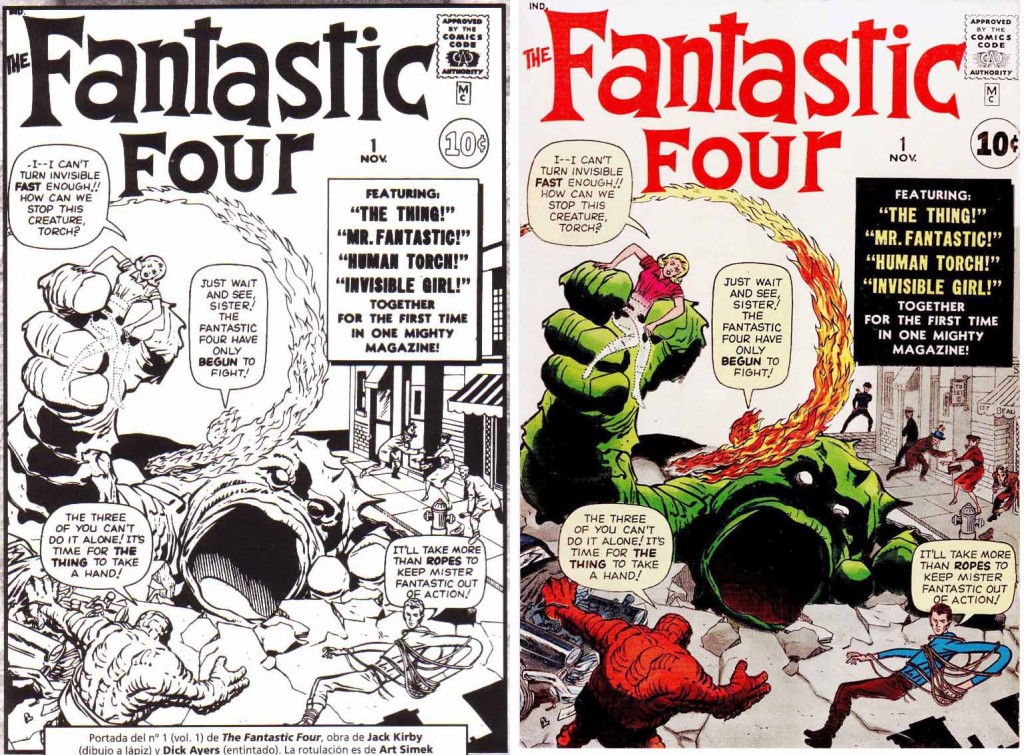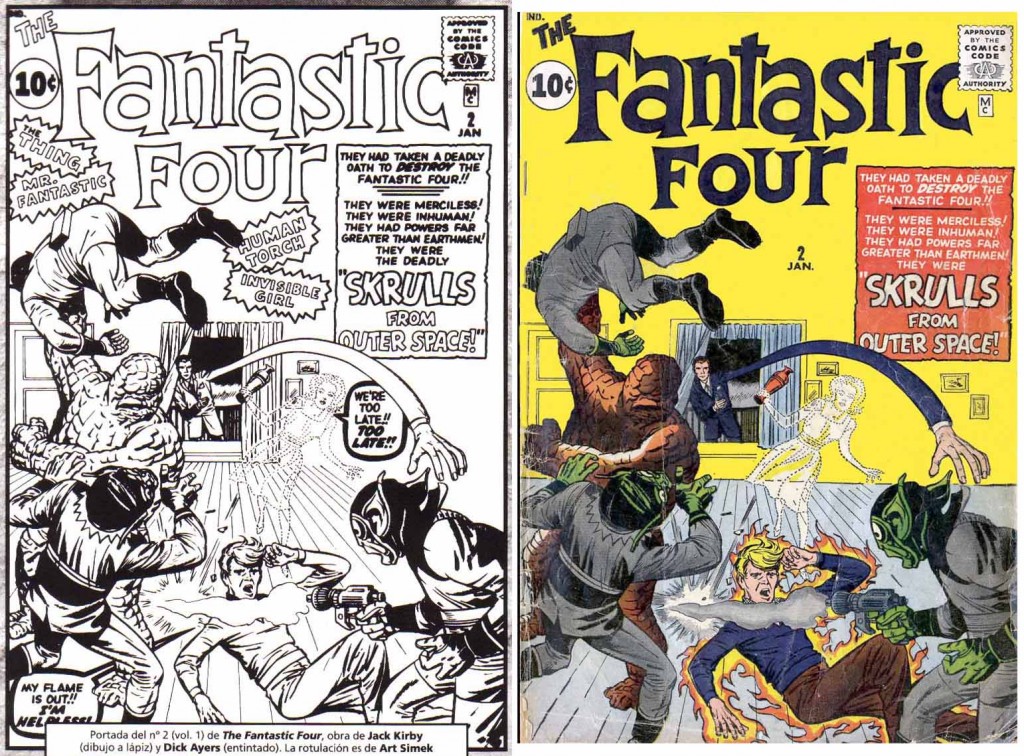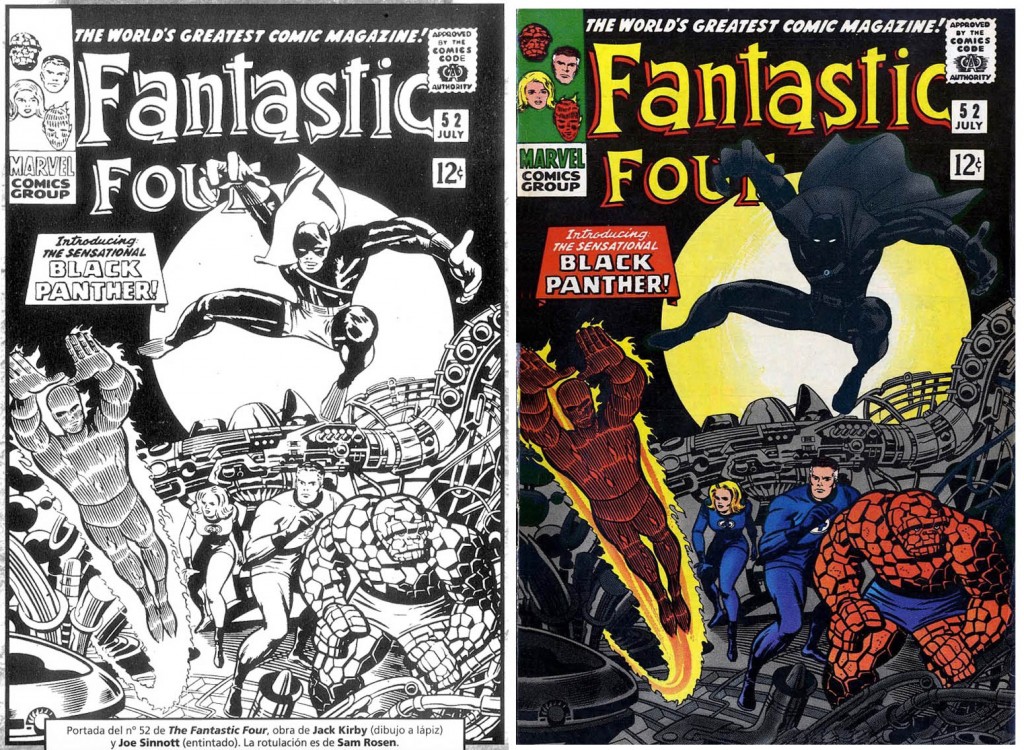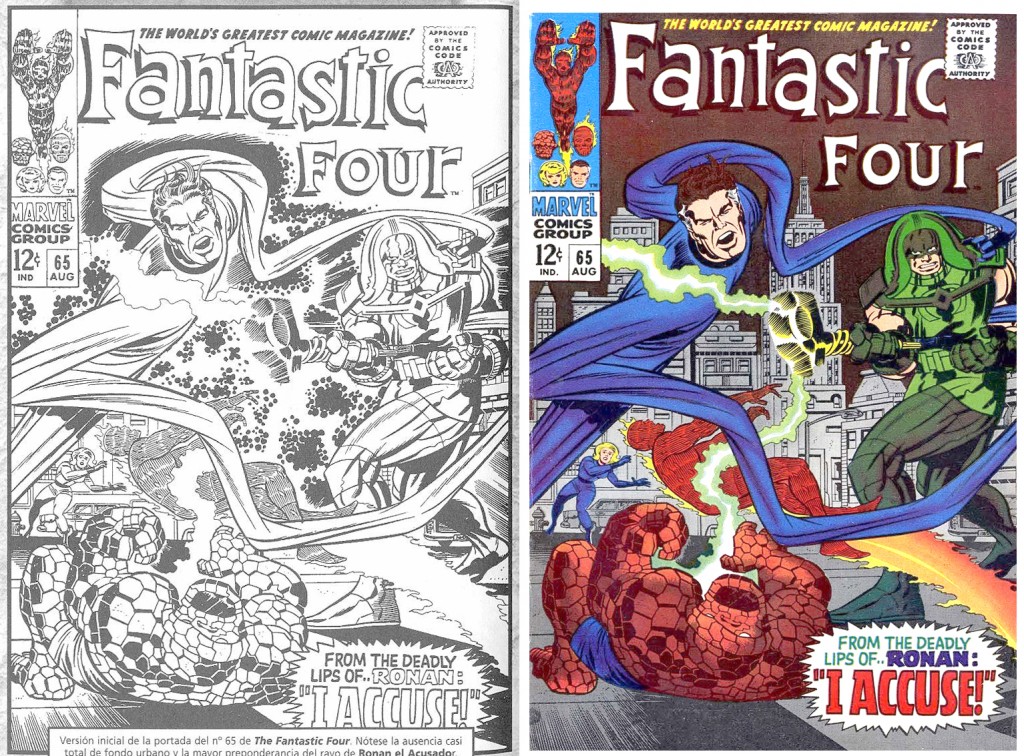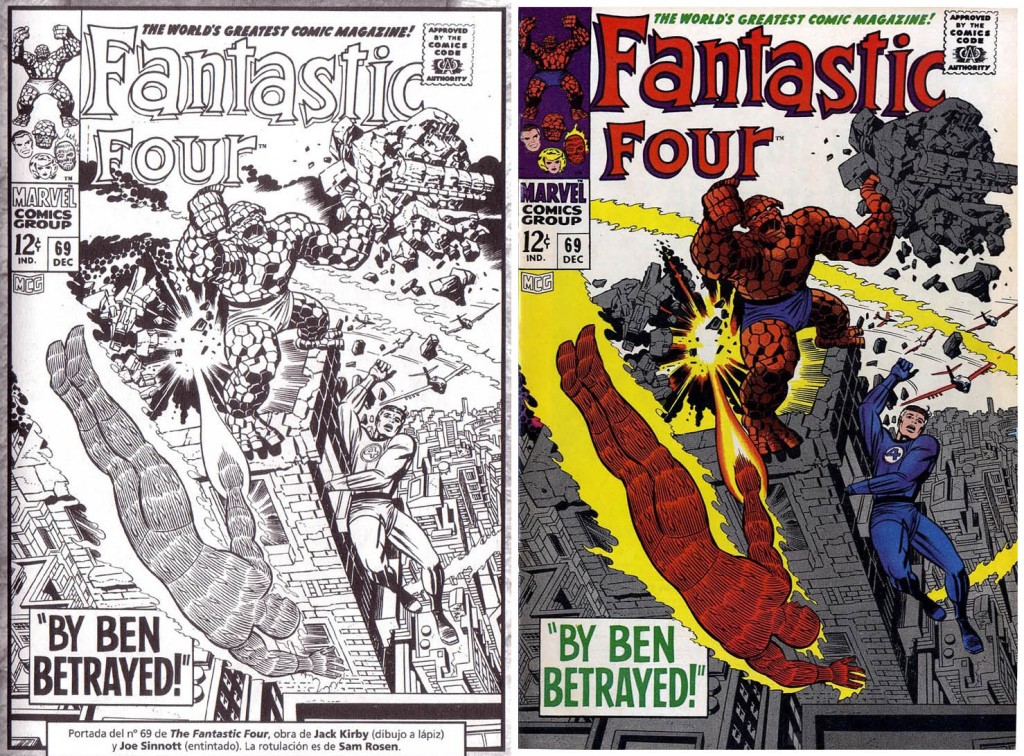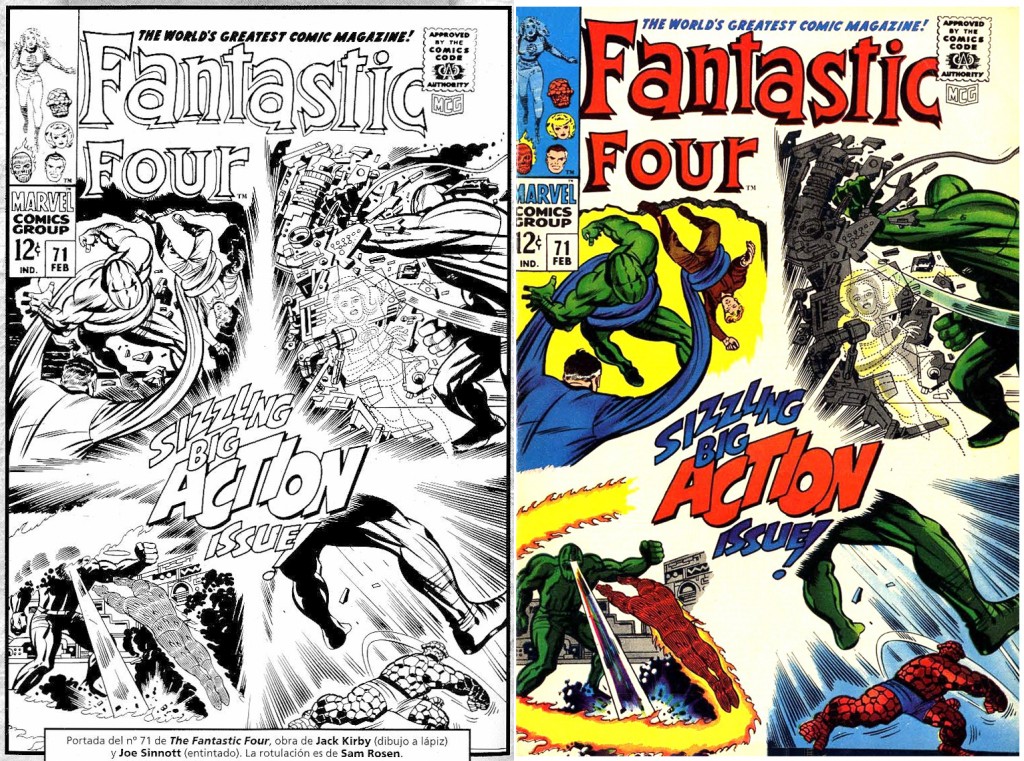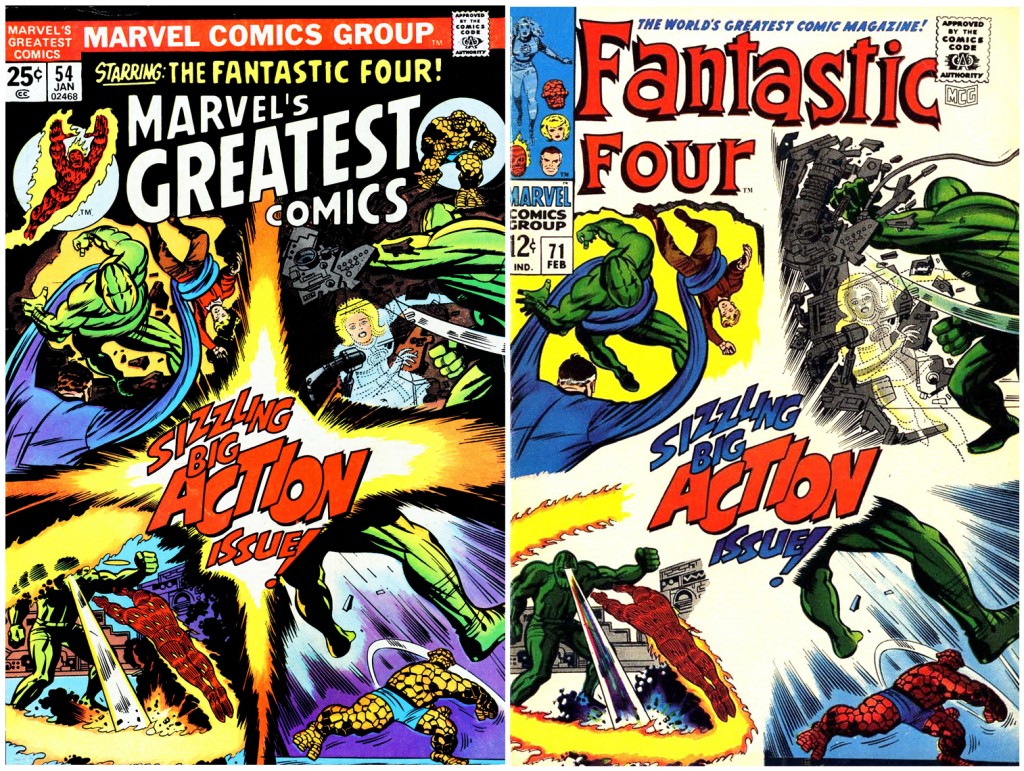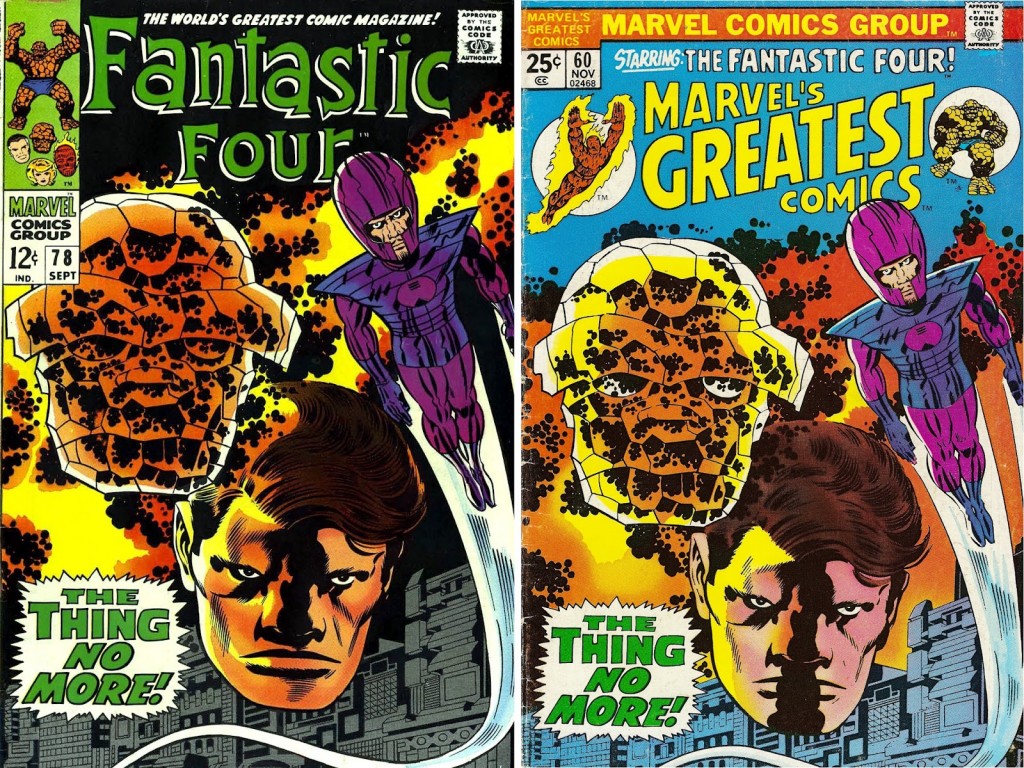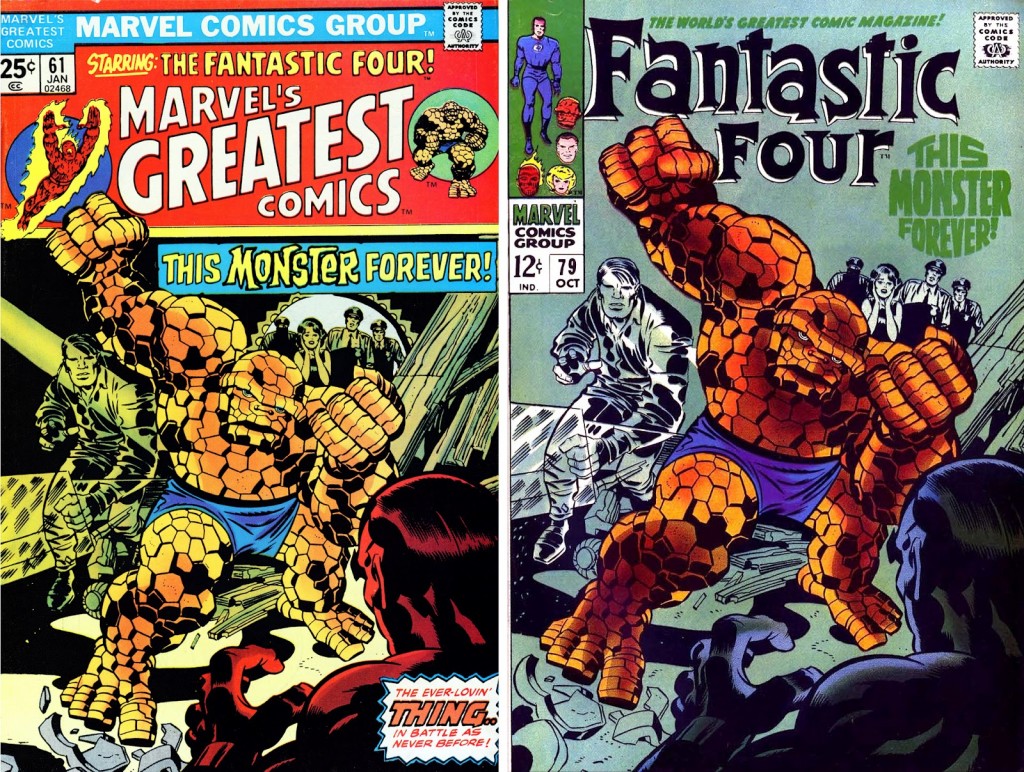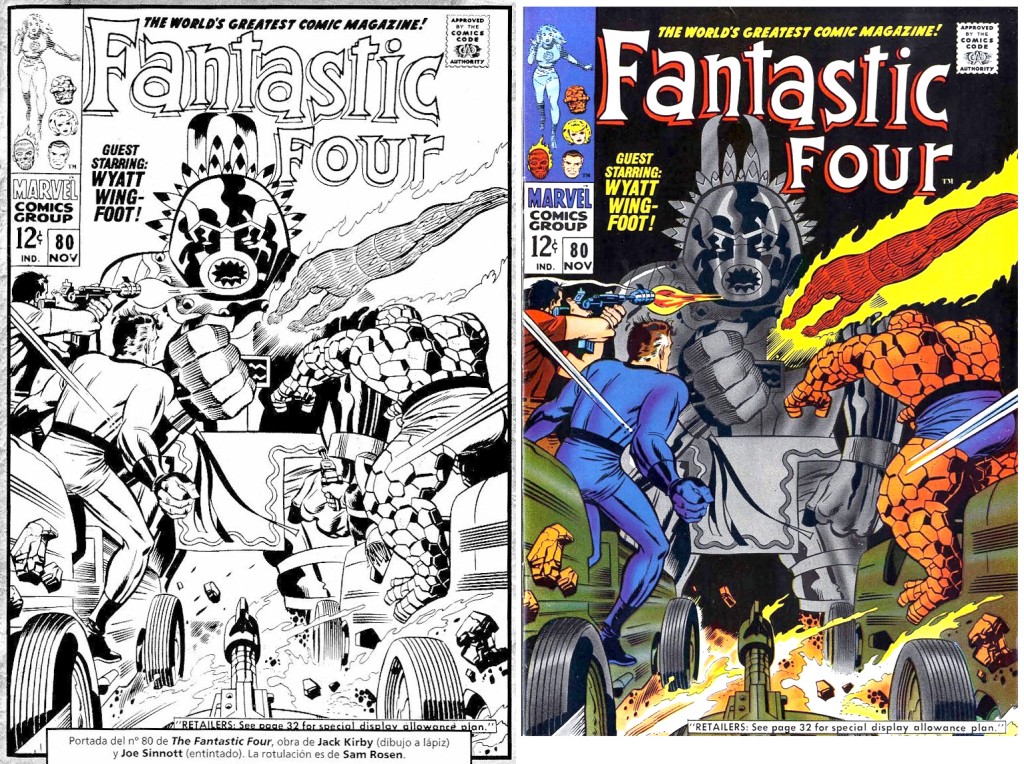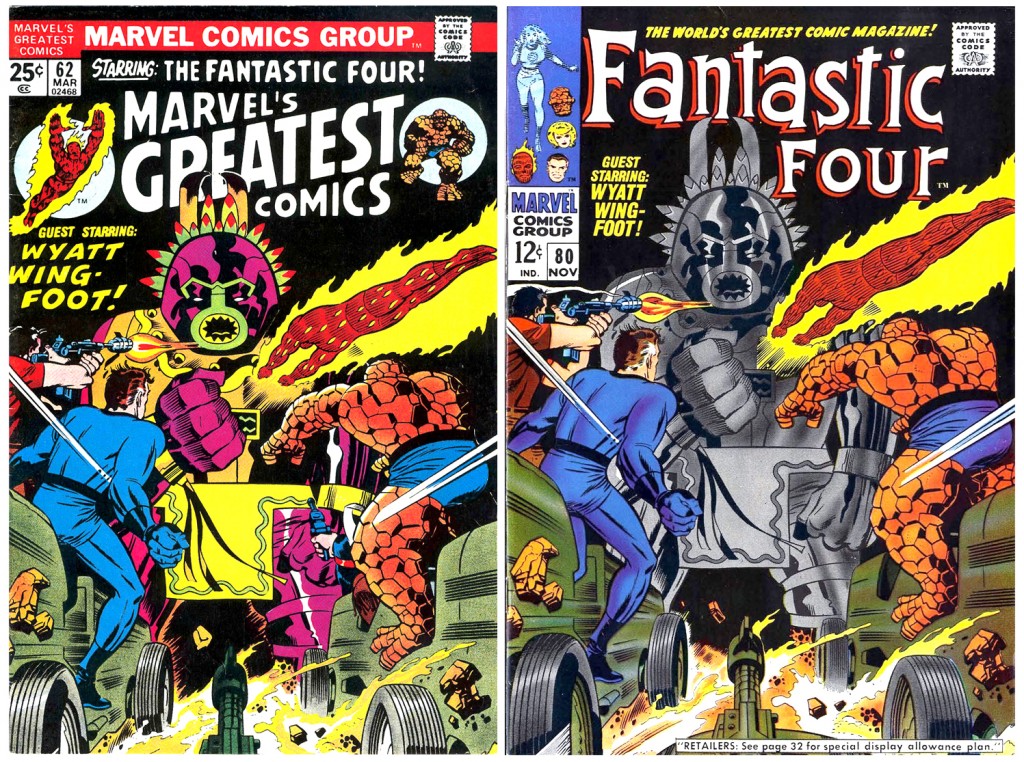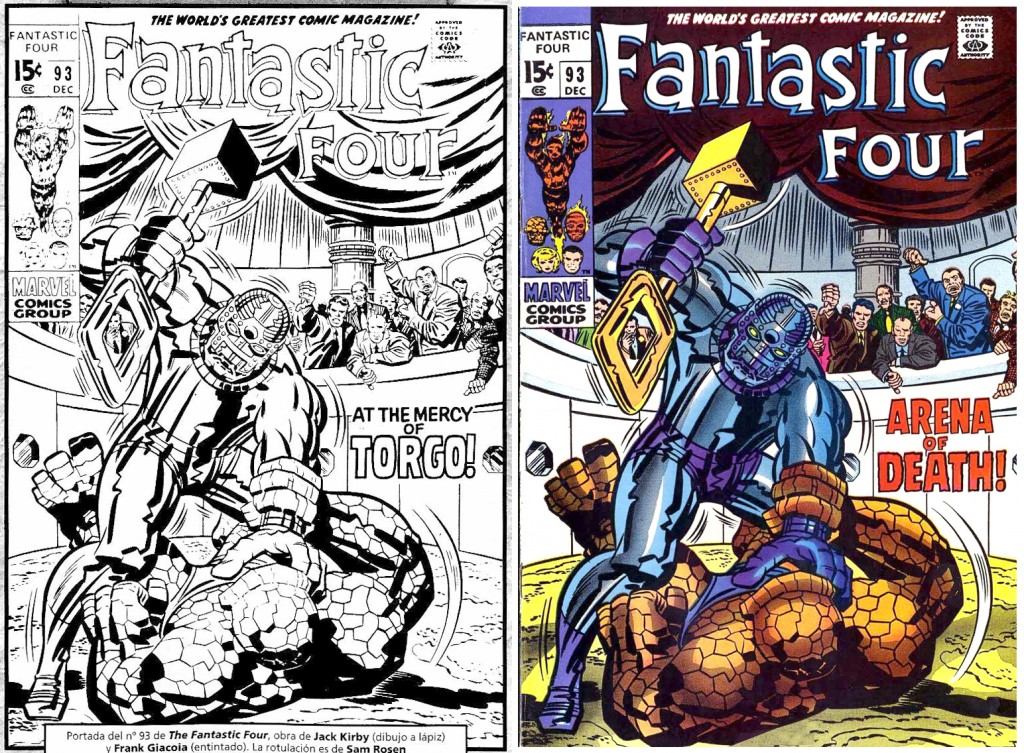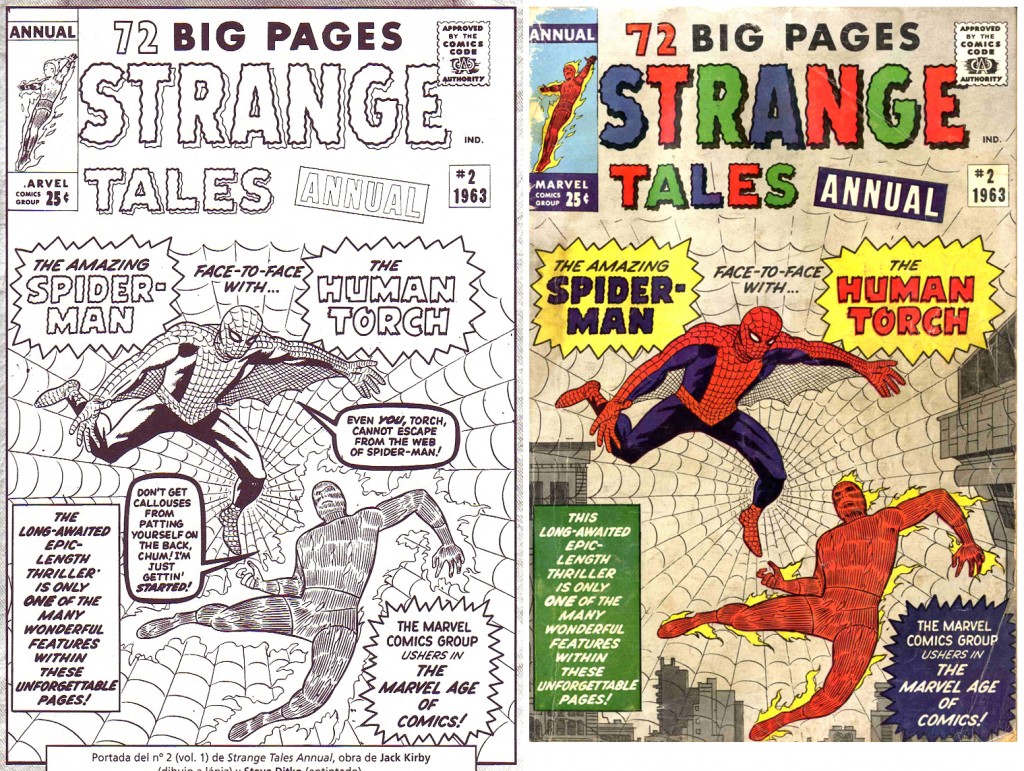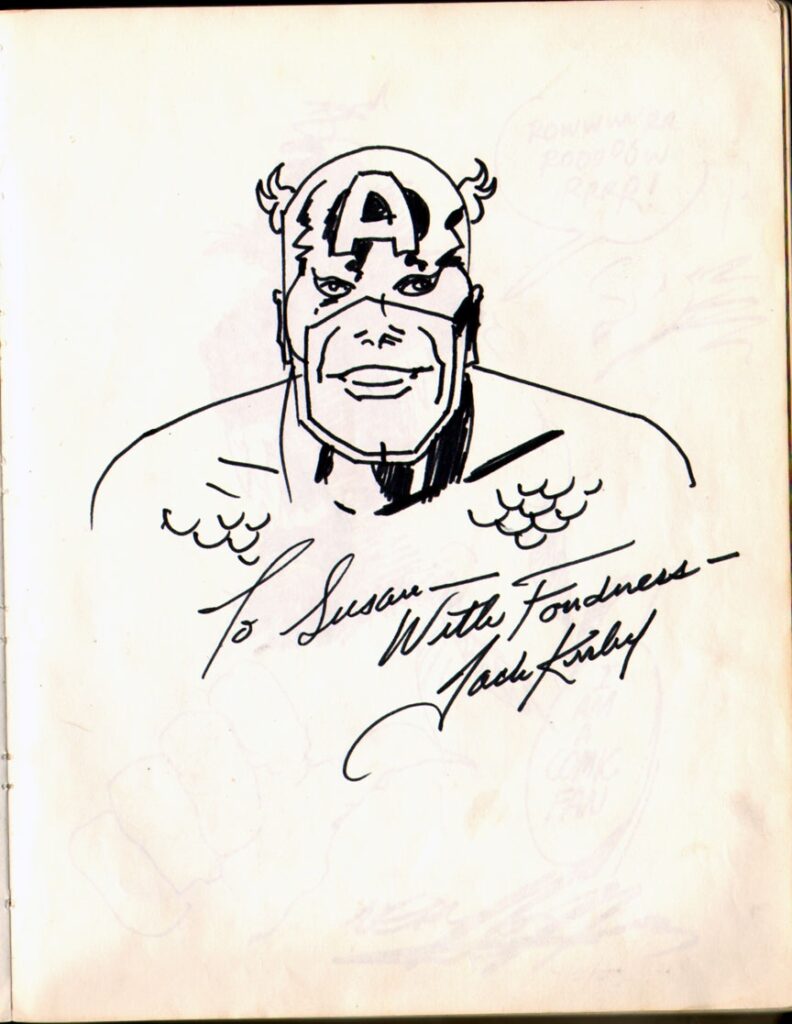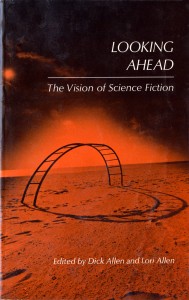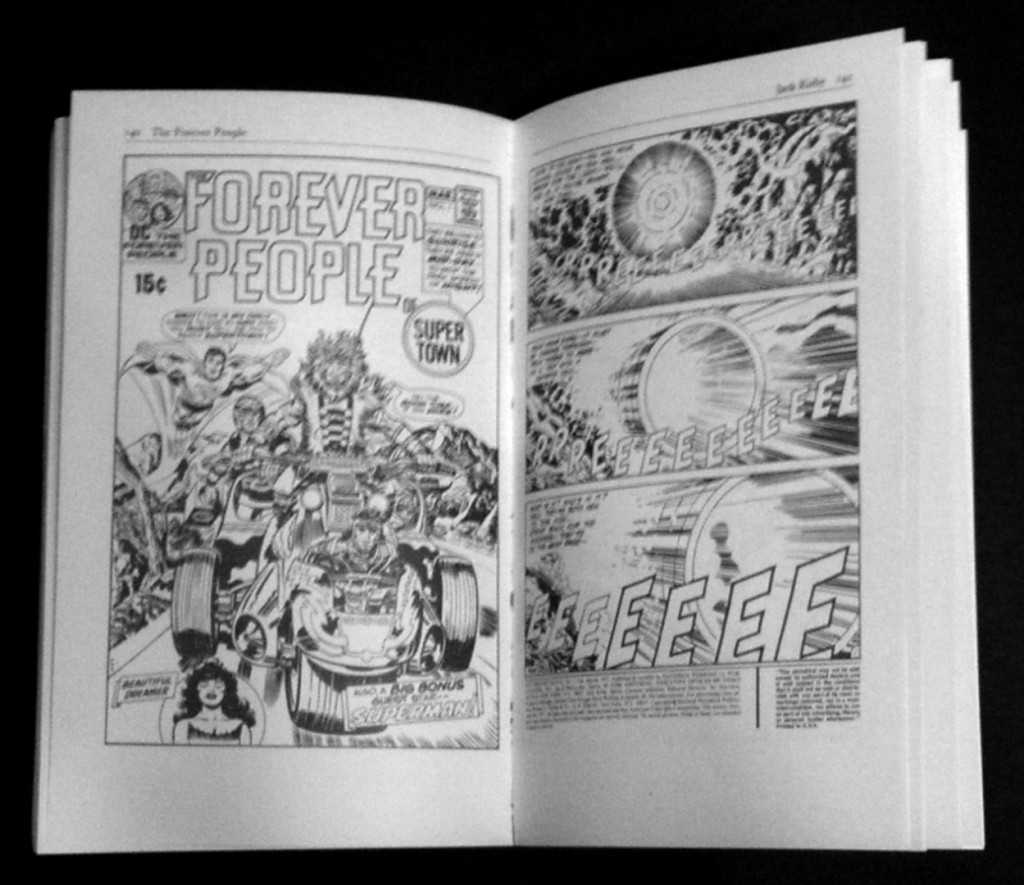Goodman vs Ditko & Kirby
by: Robert Beerbohm
Martin Goodman used Stan Lee as a conduit, as his paid go-between, with the “hired help.”
Today a blizzard rages outside, winter is truly upon us finally. Since I am not going to my warehouse in this storm to work my Internet vintage comics business today known as BLBcomics, which so far has sold in to more than 28 countries, I find I have some time now to address certain recent issues which came to my attention. Last weekend was gone to Angouleme France for the largest and best comics festival in the world. The French government also funds a wondrous comics museum in this 2000 year old former Roman hilltop fortress. It was good inter-acting again with my many comics scholar friends from all over Europe as well as America. These long time comics scholar friends rejuvenated my sense of focusing in on key core conundrum issues which cry out to be solved for posterity. This is one of my largest remaining conundrums to sort out yet.
First Off, I am NOT one of those Lee VS Kirby/Ditko “zealots.”
Never was. That line of illogical reasoning is/was/always will be stupid to me to begin with. My (so-called) comics historian primary hands-on research has NEVER been about that narrow-minded, simply wrong, view – not for me as it has ALWAYS been about: Goodman was owner.
Second, I am not one of those guys “out there” who hates Stan Lee.
The man is an international icon beloved by millions. And deservedly so on so many levels. During my teen age years I was also intensely hooked into that fantasy persona world he created, but that is not the point here. Me, I also grew up loving Marvel Comics along with ALL the other publishers.
I remember buying all the Marvel comics as they appeared on the stands – Amazing Fantasy #15 when I was ten, though at the time I liked the Ditko “bell ringer” story better. By #3 with Doc Ock battling Spidey, then Sandman, taking on Doctor Doom, the Lizard, etc, my late younger brother Gary and I were hooked.
I was not impressed with the first couple “monster” issues, consequently started on Fantastic Four with #4. Torch giving that bearded ‘bum’ a “shave” with his “flamed on” finger being the energy which got me to part with my hard earned 12 cents that day, being evicted in #9 a hoot, battling the Hulk in #12, the ink job Ditko did with Kirby’s pencils on #13 still sometimes gives me goose bumps – Hulk,Thor in Jim, Iron Man, then Captain America in TOS, X-men, Avengers, Sgt Fury, Daredevil (though it was Wally Wood in #7 which really can run a comics reader’s wagon), etc etc and I was cheering them along all the way.
Gary and I worked jobs initially at 25 cents per hour. We also collected used soda pop bottles thrown out of cars along the roads which we washed off and returned in to local grocery stores for 2 cents each. Our father would drop us off a mile or two out of town and we would walk back with our wagon picking up pop bottles in those pre-can days. As each new Marvel (or any other title from other publishers) came along, coming up with that extra 12 cents was hard chore work, but worth it to enjoy these sequential art far-flung fantasies.
We got in to dealing comics mail order when I was age 14 and Gary was 12 with an ad in Rocket’s Blast ComiCollector #47 published by Gordon B Love in Oct 1966. At some point I became the evening elevator operator bellhop (from after school till 11 PM nights) at the local Pathfinder Hotel at 65 cents per hour. Later in the evening when the hotel would quiet down was prime time comics and science fiction paperback reading. Devoured Tolkien, RE Howard Conan, ERB stories with a passion only a teenager’s naive passions can conjure. Comics collecting was also slowly becoming easier to maintain.
After Gary died of leukemia May 1967, a few days before I left, I informed my parents I was headed on a Greyhound Bus to Houston Texas for the first of what has turned in to well over one thousand comicons all over the country, then also later on in France and Italy. I lost count after that more than a decade ago. Houstoncon was June 17 18 1967. I turned 15 that Saturday, twas a swell birthday present I gave myself.
Roy Bonario, Marc Schooley, Bill Wallace, Boyd & Dee Magers, Russ Cochran, many others et al were “good medicine” helping me come to grips and grapple with my brother’s very sudden death. I shall ever remain in their debt of open hospitality which helped immensely coming out of that acute depression.
Stan Lee building the mythos back in the 60s coming in to the 70s of inter-connecting the characters being introduced like machine gun fire in the what was a then-quickly growing Marvel Universe also ran one of my wagons, but also along with all the other then-current comics coming out from ACG, Archie, Charlton, DC National, Gold Key, King, Krupp Comic Works, Last Gasp, Print Mint, Rip Off Press, Tower, Warren etc etc. I was always, and remain, driven by comics “creators,” not by the publisher brand name(s) efforts which I took in as so much (usually welcome) hype necessary to garner attention spans. But Stan was hard to ignore, his enthusiasm infectious in a mostly, initially, positive way.
I have been told by countless creator persons over the decades Stan was (mostly) a lot of fun to work with. I have never ‘met’ Stan Lee over all these years. He was always too surrounded by adoring fans for me to begin to wish to pose the queries I have for him. Maybe one day…..
Reiterated: I am not out to “get” Stan Lee on any level. There is zero vendetta, etc., etc., etc.
What I am grappling to convey in the research for my book is a tasteful way of presenting the data as I have partially sketched below based on a lot of primary hands-on research absorbed over four decades now. A “reader’s digest” version is here, as it were, as I have lots more documentation to present in laying certain myths to rest at the proper moment and space in time when Comic Book Store Wars is published.
Goodman is the liar re royalty promises.
And he has a documented established track record of breaking said promises in the past we we shall (just partially) see.
Where Stan Lee comes in to this puzzle is:
Who conveyed the royalty promises to Ditko and/or Kirby?
From Stan Lee And the Rise and fall of the American Comic Book by Jordon Raphael and Tom Spurgeon on page 34 these authors report “…(Lee) acted as a ‘supreme’ editor’ of sorts, reporting only to Martin Goodman…”
To quote Stan Lee himself on the same page “…I was just doing what my publisher asked me to do…” Lee said in an early-80s interview. “…It never occurred to me that what I was doing wasn’t that great…”
If not Stan, then who?
“How much did he know regarding Martin Goodman’s real intentions, and when did he know it” type concepts?
Ditko said what he said on the phone more than 40 years ago.
Recently comics writer, former comic book store owner, Tony Isabella, snidely pontificated on his blog “thing” how come there is no transcript and/or tape recording of a spur of the moment phone conversation in 1969 which two high school students made. We got Ditko’s phone number from directory info as he was listed in the New York City phone book. My first reaction was “What th…..?”
This phone call was brought on as Ditko had left Hawk & Dove mid stream with #3 with Gil Kane taking over. Then Gil Kane does the cover to Creeper #6, then no more books at all. What th…?
We wanted to know where the next work from one of our favorite comics creators might be appearing. Check page 95 here http://www.youtube.com/watch?v=IX24-0C4mVk for more on this, as this is not about to become some Ditko rant. I am confident in what I know to be simple truth.
There were a couple lines of reply from Ditko re promised royalties, then the conversation moved on mostly to creative concepts. But those (cryptic) lines put me on a trail for over four decades long now to get to the bottom of this (seeming) mystery as I never have bought in to the (many) myth(s) Ditko walked off over disputes over Green Goblin, etc. Pure myth.
There has also been a LOT of other research in this department in the decades since. By me and many others.
Ditko saying he left Marvel over promised royalties, trying to get Kirby to walk out at the time as well, was merely a spring board in to setting the historical record straight. I have been telling the story of this Ditko phone call since it happened. Two high school students who called him up spur of the moment right around the time Gil Kane seemingly inexplicably took over handling Creeper and Hawk & Dove. He was listed in the New York City phone directory is how we got his number.
Isabella ranted about lack of proof smoking gun documentation as part of his rationale to disparage me once again out of the blue. 1969 technology to easily make a “recording” did not exist for two high school kids then especially on a spur of the moment phone call.
We did make up a ditto master that week end of the phone call.
We were going to print it in Fanzation #3, but then a couple weeks later got a letter from Ditko asking us not to use what he had said on the phone. Instead, Ditko wrote us a letter on fan creativity we printed which Fredrick Wertham later quoted in part as he also mentioned Fanzation #3 by name in his last book The World of Fanzines (1974).
Wertham referenced Fanzation at least nine times in his last book before he died wherein he also exonerates us comics fans as having turned out alright. I exchanged many a letter with the doc, who was instrumental in bringing on the self-imposed constrictions by scared publishers of the Comics Code, defending comics fans every where. Those letters by him to me destroyed in a 1986 northern California warehouse flooding just 43 miles south of where Eclipse Comics HQ was washed down the Russian River of a firm I once ran called Best of Two Worlds, but I digress….
Some where amongst my “stuff” is that ditto master. Believe me, have been looking for it again for some time this past year or so in my “new” 4000 sq ft warehouse as I sort out the shattered remnants of my life regarding the pit I fell in to with the hip joint replacement and recovery healing scenarios
That fellow who recently died, Mark Alexander, RIP, whose text has became the recent Jack Kirby Collector #58, has interesting tid-bit data to be gleaned in his justly-named tome LEE AND KIRBY: THE WONDER YEARS (TwoMorrows Publishing) which actually further solidifies the concept of Stan Lee directly inter-facing for Goodman with the creator people. Goodman hid behind Stan Lee to do the bidding he paid for.
One key section re the 1949 bullpen dissolution comes to mind off the top of my head. I will be pulling page numbers once I have his “book” in front of me again. The clues are all around in a published record dating to back at least 1966.
Later on former editor-in-chief Jim Shooter also comes to mind when he was always referring to the upstairs “suits” (ie new owners) as he followed their dictates re creative people best he could in order to maintain his job.Yet people inexplicably blamed Shooter? Again, I utter, “What th…?”
Query: Why does Stan Lee get such a pass when following the dictates of earlier owner Martin Goodman? Just saying…..
I First Met Jack Kirby in 1970 at the first San Diego Comicon.
Having first met Jack at the first San Diego Comicon in 1970, I had countless talk raps with Jack Kirby at comicons all over the country in the decades since, as many of us older timers were blessed with, but the most intense one was during a mid 70s El Cortez SDCC back when it was still known by many as “Golden State Comicon.”
I had a prearranged meeting of time with then-wife Susan to catch up next to the El Cortez pool at 6 PM.
Dealer room across the back street in that building the Cortez owners had put up closed then and out I come streaming across with a very proud possession I had won in heavy competition with others therein which was the then earliest known Simon & Kirby original art out on the market place, a page from Star Spangled Comics #19 1942 wherein S&K had Hitler’s Nazis conquer New York City changing Times Square in to Hitler Strasse on the page, a Nazi on a huge horse inside a church in another panel, powerful it remains, almost a thousand dollars it had just cost me in cash and trade, proud still I remain for once being its owner. I loved that page, still miss it very much.
As I came up to Susan I was gushing about this wondrous newest edition to my then burgeoning pile of comics “stuff” which had grown in to a way of life for so many of us back in the day. Having sold out from Comics & Comix in 1975, I had gone “solo” again Nov 1976 opening up first in the Haight Ashbury, San Francisco, right across the street from the historic Straight Theater. By May 1977 I re-occupied 2512 Telegraph Ave when my former partners moved their flag ship a block closer to the campus. A few years later we got Best of Two Worlds moved even closer on The Ave to UC-Berkeley campus, but again, I digress….
Almost oblivious to my fan boy enthusiasm, Susan went, “That’s nice, dear, I want to introduce you to my new friend Roz. We are waiting for her husband to show up. Then the four of us are going out to dinner.”
For a couple minutes there, lost in my own excitement of what I had just scored, I was oblivious to what Susan had just uttered re “Roz” right up until Jack Kirby, ever present entourage in tow, comes walking up. After exchanging pleasantries the four of us then got in to the Kirby car. Off we went for a memorable dinner and talk fest.
During the course of this dinner was when I first asked Jack, along with Roz, about Ditko’s afore-mentioned claim regarding ‘royalty’ concepts. That Ditko had tried to get Kirby to walk at the same time.
Jack corroborated Ditko’s “testimony” of initially agreeing to walk, then backing out at the last moment, So did Roz. The thought pattern as envisioned by the two which Ditko had presented to them was paralyzing Marvel so Goodman would finally listen.
Jack, and rightfully so, a product of the Great Depression of the 1930s, was ever fearful of not being able to provide for his kids month in, month out. He could not take the risk. He had earlier burned a bridge via DC via a scenario over Sky Master newspaper comic strip with Jack Schiff who was still working there. [His long time friend Carmine Infantino, though, was soon to become DC publisher.]
I learned a lot that night regarding Jack and Roz’s life in comics from which I followed up occasionally over the years with further queries to flesh out time lines in my head thinking one day I wanted to compose some sort of history book on the business of comic books in America.
My guess at the date of this conversation remains torn between either 1977 and 1978. I am leaning towards the latter based off what happened right after dinner before we headed back to the Comicon area of San Diego.
As a wondrous (to me) sidebar of sorts: Following dinner, once we got to the Kirby car, Jack and Roz led Susan and myself to the trunk. Opening it, they showed us 600 pages of Kirby original comic book art from Marvel and DC. They said to me they were seeking three comics ‘dealer’ persons they could trust to each buy 200 pages for $20 each and not try to flood the market so Jack’s “average” originals would maintain their market value then from $30 to $100 each for the most part. I was in that trunk “first” – joyously I picked out page after page from Captain America, Demon, Omac, Mister Miracle, New Gods, Mr Miracle, Superman’s Pal Jimmy Olsen among other stuff. It was hard having to pass up so many other cool pages limited to I was to ‘only’ 200 of them.
Also that night at dinner Jack drew a bust of Captain America for Susan, signed to her, now available for viewing in my CAF gallery here.
Stan was forced into being between a rock and a hard place re maintaining his job with Goodman.
– or possibly taking some sort of higher path which would lead, I am sure, to Stan being pushed out the door by Goodman. “Conduit” is the descriptive word which will most likely be used in my book
– I am more than open to other descriptive terms along similar type lines
This is the way i see it and I do not base this on “idle” speculation. I have examined a overwhelming preponderate amount of the public record, conducted innumerable interviews over the course of 40+ years being in the comics business myself.
I am not a comics “creator” as such – unrequited to be sure – my efforts in the wonderful world of comics have always been equally fascinated by the business side of the world of comics as that is the side I have made my living at self employed for said 40+ years now. In the course of these endeavors I examine the historical record on so many myriad levels of the comics business all the way back to re-discovering America’s first actual comic book being published in 1842, killing the myth of the Yellow Kid being the ‘first’ of anything, etc as so much is now relegated to comics “archeology.” Most of the players are now dead though they do leave ‘paper trails’ to examine.
The lies were Goodman lies.
Makes Goodman the liar re royalty sharing promises as those books took off in the early to mid 60s
Ditko has written in print wherein he maintains he never met Goodman.
Yet Goodman made promises of royalties – both to Ditko and Kirby. Question therefore becomes, and this is “key”…..
How, or from whom, did Ditko and/or Kirby receive those royalty “piece of the action” promises?
This is more of a rhetorical question I have been grappling with the answer to as one boils away all the layers leaving the kernel of “Occam’s Razor” supposed “truth.” Some one, please, provide me with an answer to that question.
re Kirby and the concept of Royalties.
FACT: Simon & Kirby blew out of Timely re broken Goodman promises re Capt America royalties
– so, the die had already been cast re Goodman being a liar regarding sharing building up wealth in that department
FACT: Simon & Kirby pit stopped at MLJ for a month, then over to “DC” where they got a 50-50 split contract on their work there.
– especially on those first few block buster Boy Commandos though how that worked with Batman already in Detective Comicsremains a partial puzzle to work out.
FACT: Simon & Kirby becomes the first creative comic book team in history to have their names used as the SOLE reason to buy certain DC comics – not Siegel and Shuster, Bob Kane (Bill Finger), etc.
FACT: Donenfeld, Goodman, et al, many of these publishers, communicated on levels on how to control the “help” and Donenfeld had become a master at it keeping Siegel at bay since 1939 when Siegel moved to Long Island for a spell as Superman took off in comic books, radio, newspaper strips, and much merchandising. Shuster was more easily manipulated otherwise Superboy would not have been given away as it was at the time. Joe Shuster was much more manipulated than Siegel.
FACT: Simon & Kirby come out of the war, and EVERY deal they set up, whether Harvey, Crestwood, etc.
– they are ALL 50-50 royalty splits till bouncing in to Charlton in 1955 hat in hand. Comic book industry is imploding by then
FACT: Simon & Kirby took it once step further to began self publishing via Mainline Publications, but Harry Donenfeld maneuvered them, plus Andru & Esposito as self publishers, plus Gaines’ EC, etc, into Leader News distributor, a company my research tells me Harry secretly owned which I found out from seeing papers that Irwin Donenfeld personally showed me during my interview sessions now a decade ago – total manipulation.
FACT: from 1942 thru 1954/55 Simon & Kirby are 100% used to 50-50 royalty sharing promises in contracts with major comic book companies.
So, these are just SOME of the background set up facts coming to bear in this aspect of my forth-coming book I have dubbed Comic Book Store Wars.
Now forward a bit in time:
Enter The “Marvel” Age.
Ditko, but vastly more so Kirby, state here and there over the decades re royalty promises from Goodman, owner, which never materialize even though Marvel circulations are exploding upwards – we know this from published paid advertised records Goodman ran aimed at periodical distributors and retailers. I have many dozens of examples which are being sorted out from the storage they ended up in while I sought medical repair, then recovery healing.
Stan Lee, as far as I can ascertain, never owned a piece of Marvel – ever
Martin Goodman was the owner.
Repeat of previous thought: Ditko states he never met Goodman
Hence, question remains: How did that info pass back and forth?
Further Question remains: was Stan an unwitting participant in said “negotiations” ?
Hence, the word “conduit”
Does that necessarily make Stan a villain here?
Hell, no!
Where that concept enters the POTENTIAL fray is post Goodman selling out with material like “How I Invented Spider-man”, or that 1966 New York Herald Tribune “interview” with San and Jack wherein Stan states point blank many a time all he does on Fantastic Four is suggest to Jack who the next villain might be, or the texts in those Origins series books from Simon & Shuster in the mid 70s, and many other places in print elsewhere, or the innumerable radio interviews, TV interviews early on, where one begins to see an altering of the perceptions of what proper historical reality fact(s) should be.
– and remains for me a very slight conundrum in best how to phrase HOW Stan was able to maintain his job description with each successive waves of Marvel owners as the company kept getting sold, re-sold, re-sold yet again, etc etc etc all the way to Disney who are now going after creator Gary Friedrich for “losing” his court case over Ghost Rider. For shame, Disney, but I digress once again….
Each of these new successive owners’ primary concern(s) would be:
“Do we really own unfettered what we just bought?”
Some one had to get out there and state so thusly way back when post-Goodman ownership. Some one with a P.T. Barnum flair for media showmanship possibly?
Some one who claims later on a (highly selective) lapse of memory concerns?
Therein lies the further conundrum of how to state obvious scenarios tastefully and tactfully in actual print in a paper book which I will get finished sooner than later now.
Recently I got a welcome response from a former Marvel co-worker deep inside the Marvel machine thru part of this time:
“….You set out the situation quite well, and I can certainly accept that Stan may have been (probably was) the conduit from Goodman to Ditko if such promises or even hints of same were made. Oh, it could have been done through Sol Brodsky, but Stan is more likely.
“Of course, I don’t unequivocally accept what Ditko may have said as true, even if he believes it, but I’m certainly willing to accept that it could have happened that way.
“Does Stan remember the episode(s) if it did? I wouldn’t bet on it.
[BLB here: Personally, I think Stan’s memory losses to be highly selective many a time, my personal opine no way reflective or disrespect meant on any level on the letter writer I quote here – or towards Stan for that matter.]
“I’ve never claimed Stan is an absolute paragon of virtue – which of us is? – only that calling him a liar in the ownership dispute is shooting the messenger.
“That different versions by Stan telling of the creation of characters see things differently is of course true… including the letter Stan wrote saying he considers Ditko as the co-creator of Spider-Man…..”
I have no intentional intent to “…shoot the messenger…” but,
Where I have “trouble”….
– and sincerely seek to resolve as point on accurate historical fact as humanly possible
– with Stan’s contradictory multiple version(s) of events over many years since Goodman sold out.
– is actually that main early first decade post Goodman selling out.
This is what I have laid out already which this person who was ‘there’ wrote wanting to agree “…you set out the situation quite well, and I can certainly accept that Stan may have been (probably was) the conduit from Goodman to Ditko if such promises or even hints of same were made….”
That first decade Stan laid claim in print by his own hand, in interviews printed and broadcast all over the place, to virtually all aspects of creation of those company “properties” – this is where, what, why, who I am seeking to resolve – as that aspect, to me, is where/how Stan was able to retain his job with each wave of new Marvel owners.
Stan writing the more recent Spider-Man “origin” letter ‘giving’ Ditko co-creator status finally he referred to comes many many years after this crucial first decade.
As gleaned from long time friend R.C. Harvey’s review of Stan Lee And the Rise and Fall of the American Comic Book on page 124 of The Comics Journal #258 (2004), Ditko wrote in Robin Snyder’s The Comics,
“…Stan chose not to know, to hear why, I left…”
I believe, led there by examining virtually all the in print “facts” my (so-called) comics archeology trail has led me, absorbing the unfolding pathos since consciousness was first raised in 1969, as well as literally many hundreds, thousands?, of conversations over the decades, Goodman did indeed make promises of royalties if/when the properties “took off” which led Marvel out of the “wilderness” in to the “promised land.”
I had too many conversations with Kirby at comicons over a long time wherein he described to me more than once that, yes, Ditko did try to get him to walk at the same time back in 1966. At first Kirby told Ditko “yes” he would, then backed out at the last sec. Jack wanted to, but felt he could not as he had kids to worry about, Ditko did not have kids to worry about
My comicon conversations with Jack Kirby were spring boarded by that spur of the moment Steve Ditko call in ’69.
We were worried at the time WHY Ditko had first all of a sudden left Hawk & Dove (Gill Kane took over, natch) and then abruptly Kane does the cover to Creeper #6, then books are cancelled. Ditko’s recurring tuberculosis had made a comeback he needed to recover from. Same reason he had to leave comics in 1956 for a spell, head back to Johnstown PA to recover.
The portion of the conversation where Ditko said why he walked off Spider-man was very brief, but to the point. Most rest of it was about his new stuff/plans, on creativity, etc as he had dismissed the concept of ever coming back on Spider-Man.
It is scenarios like described above, another example being of Harvey Kurtzman went through in his wars with Bill Gaines over Mad Comics, which brought Robert Crumb to the realization of getting Zap Comics published back in 1968 there-by ushering in the comics reality of creator-owned, royalty paying comics when guys like Gilbert Shelton self-published Feds N Heads introduced his icons of a generation Those Fabulous Furry Freak Brothers, Jay Lynch, Skip Williamson etc started Bijou Funnies and so many hundreds more titles. The land scape was forever altered with the advent of Zap Comics being taken national by Print Mint summer of 1968 leading directly to the main origin of what we call today the Direct Market.
On my own level, nowhere nearly as important to comics history, yet in a semi-similar vein, I have been witnessing myself of late being “written out” of ever having been a founder, a partner, a co-owner, of Comics & Comix, the first chain comic book retailing chain store operation in the USA. Not just inside Bill Schelly’s recent “Founders” book, other places as well. Without me, Comics and Comxwould never have gotten off the ground – it would have died a still birth just a few months in to opening that first store in Berkeley at 2512 Telegraph Ave – fact. -:) Heck, I even thought up the name Comics & Comix.
Or ever having been the MAIN juice for getting Jack Katz’s The First Kingdom off the ground such as that little project was, and remains, an anomaly of sorts though Roy Thomas graciously ran a letter from me in Alter Ego #106 partially storing that data for future comics historians to puzzle thru who dun what where . I also have been experiencing personally seeing proper history simply alter and then being misinterpreted.
Perception becomes reality if left unexamined, unless challenged, and people then refer to previous published texts as “gospel.”
I would really like to interview Stan.
though I have never figured out how to approach him on the concept even though I met him long enough to obtain his sig as shown here http://www.comicartfans.com/GalleryPiece.asp?Piece=753123&GSub=113438 in 1995 when I had just then-recently begun serious work on Comic Book Store Wars.
I am NOT about trying to do any drive-by shootings on any body. I am a simple (semi) humble (so-called) comics (archaeologist) historian of the business of comics simply trying to document supposedly (to some) unrecoverable truth as best as possible from 1842 to the 1980s for posterity at this stage. Now, this missive has grown longer in scope than I anticipated when i sat down to pen this query – sorry, tis not an easy or short tale to tell.
I hope and trust my forth coming tome Comic Book Store Wars will be as accurate as humanly possible. I welcome commentary and rationales with differing points of view if backed up with documented proofs of sorts and/or interpretations of same.
———————
— since 1966 —
Robert Beerbohm Comic Art
PO Box 507 Fremont NE 68026
www.BLBcomics.com 402 459 1709 cell
http://stores.shop.ebay.com/BLB-COMICS
http://www.facebook.com/robert.beerbohm
http://www.facebook.com/BLBcomics
http://www.youtube.com/watch?v=jYyttEu_NLU&feature=relateß
Longtime Member: Grand Comics Database : www.comics.org
Co-Moderator: www.yahoogroups.com/subscribe/PlatinumAgeComics


